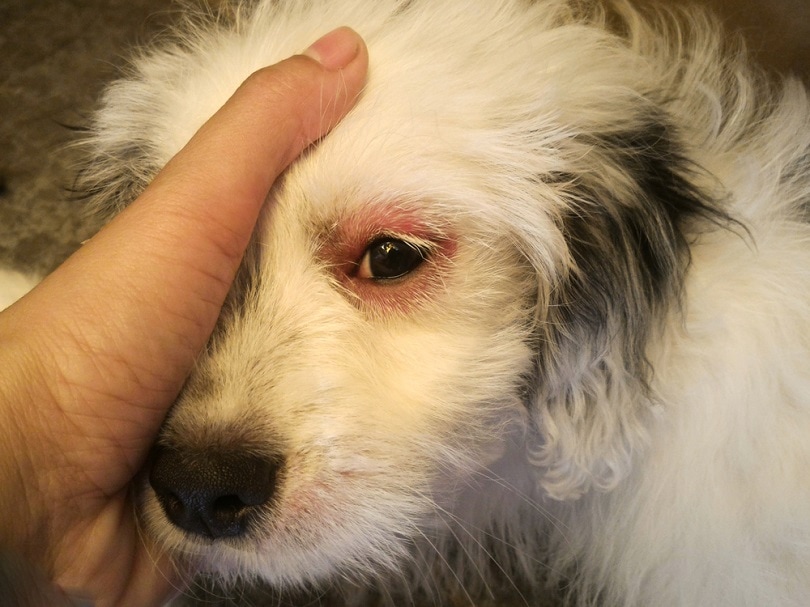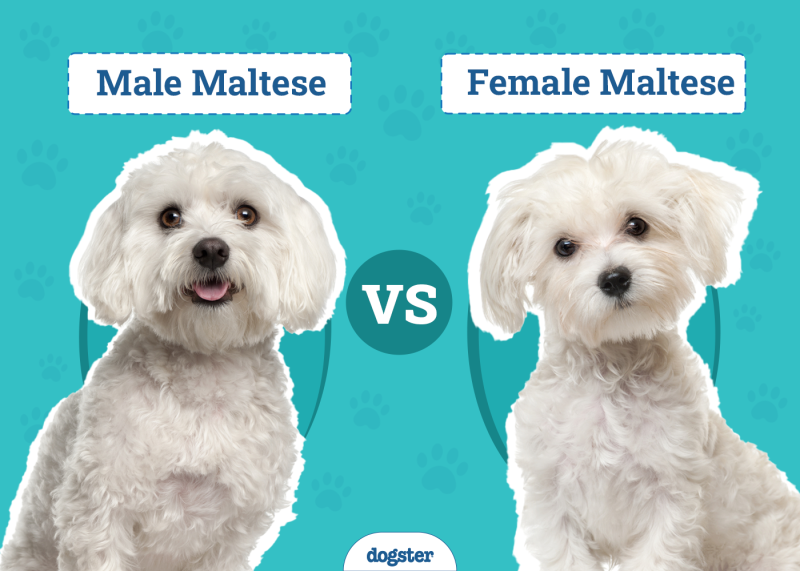As pet owners, we all become concerned if we notice something wrong with our beloved canine. If you have noticed a red eye or eyes on your dog, several factors could be causing it. We will review the most common causes of red eyes in dogs and give you some valuable advice on how to handle it.

The 13 Reasons Why Your Dog’s Eyes Are Red
1. Foreign Body in the Eye
We can all relate to this; a small object can enter our eyes and cause irritation. Dust, grass, hair, or a small flying insect stuck to the eye surface or under the eyelids can cause a red eye. A foreign body on the eye usually affects only one eye, with some exceptions. For example, if your dog was running around in a very dusty place, they might have gotten dust in both eyes.
Try to inspect the eye visually, and if you see anything on the eye and your dog cooperates, you could try flushing the eye with copious amounts of a sterile 0.9% saline solution. Chances are your dog might resist the treatment, or you might not feel comfortable doing it. In this case, make a visit to the vet to get the foreign object removed and assess if it’s caused any damage to your dog’s eyes. If this is the case, your vet can prescribe your treatment so your dog’s eye can return to normal soon.

2. Allergies
Allergies are a common cause of red eye in dogs. Pollen from grass, trees, and weeds, as well as house dust mites, mold, and even food, are common allergens that can cause red, itchy, and watery eyes. Sometimes, allergies are presented with other signs, such as itchy skin, sneezing, and runny nose. As part of the treatment, it is important to determine what the dog is allergic to. This can be done with a series of tests or with elimination diets. Your veterinarian will help you discover the cause of the problem. The treatment might include antihistamines or anti-inflammatory eye drops, as well as oral or injectable medication.
3. Conjunctivitis or Pink Eye in Dogs
Conjunctivitis is an inflammation of the conjunctiva, the clear layer of soft tissue covering the eye. This can be either infectious, caused by viruses, bacteria, or parasites, or noninfectious, caused by immune-mediated inflammation, allergens, or irritant substances. Most cases of conjunctivitis are accompanied by puffy eyes or swollen eyelids, and they also present with some kind of abnormal eye discharge. The treatment will depend on the underlying factor causing it, so visit your vet to get an appropriate diagnosis of the cause.
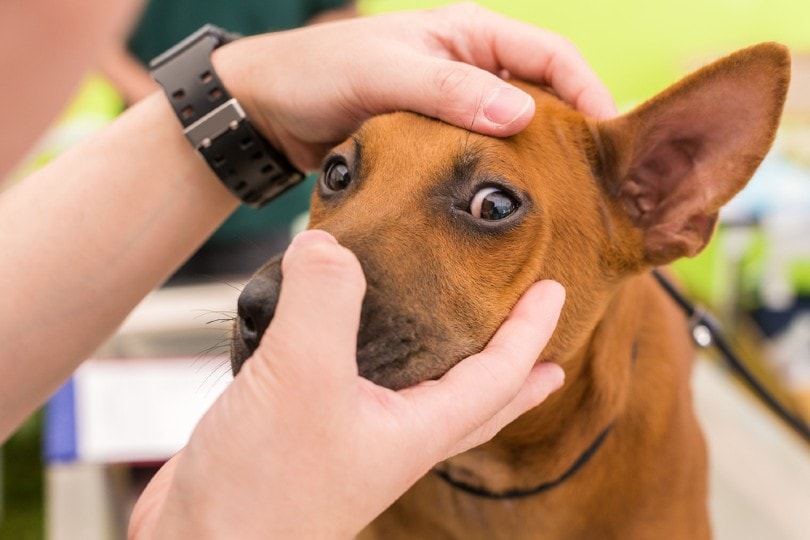
4. Dry Eye (Keratoconjunctivitis sicca)
Like humans, dogs can suffer from dry eyes due to a lack of enough tear production. The veterinarian will perform a Schirmer tear test to evaluate the secretion level of the tear glands. It consists of placing a special paper strip on your dog’s eye and measuring the amount of the watery portion of the tears produced in 1 minute. If the tear production is insufficient and the diagnosis is dry eye, your vet will investigate the cause of it. You will need to apply lubricating eye drops on your dog’s eyes several times a day and other treatments, depending on the cause and the damage to your dog’s eyes.
Most cases of dry eye in dogs are immune-mediated and are usually chronic. That means the dog will require eye medication for the rest of their life. Some cases can be caused by neurological damage or drug toxicity and may resolve after some time.
5. Dog Entropion
Another common cause of red-eye in the dog is eyelid entropion. This abnormality causes the eyelid to roll inward, so the eyelashes and facial hairs are rubbing against the eye, causing irritation, discomfort, and, in the worst case, ulceration of the cornea. The most effective treatment for this condition is surgery.

6. Distichiasis
In the case of distichiasis, there is an extra set of eyelashes growing from the glands in the eyelid margin that may be directed toward the inside of the eye. Like entropion, it causes irritation and can also lead to a corneal ulcer. The treatment is to remove or destroy the follicles of the abnormally growing eyelashes with surgery, electrolysis, or cryotherapy.
7. Corneal Ulcer
A corneal ulcer is the damage of the thin, transparent layer on the eye’s surface. Corneal ulcers are very painful and can get infected. The possible causes are trauma, abrasions, substance irritations, dry eye, infections by bacteria, fungus or virus, and parasites.
To diagnose a corneal ulcer, the vet will perform a fluorescein test applying a fluorescent green dye to the eye to see any potential wounds or scratches. The treatment will depend in part on the severity of the damage and the cause, but usually, the dog will need different eye drops several times a day, a cone collar to avoid further lacerations, and oral anti-inflammatory and pain relief medication. Severe cases could require surgery.
8. Blepharitis
Blepharitis is an inflammation of one or the pair of eyelids, affecting one or both eyes. Causes of this can be infection, trauma, irritation, or allergies. It could also be caused by a tumor. The vet will need to find out the cause of blepharitis to be able to treat it accordingly.
9. Cherry Eye
When cherry eye occurs, the tear gland that is usually hidden under the nictitating membrane or third eyelid protrudes, appearing as a pink or red bump (“cherry”) in the inner corner of your dog’s eye. The gland becomes inflamed and damaged if it stays out of its normal position for too long. This ophthalmological condition is typical of short-nosed dog breeds and requires surgery; the sooner, the better. If you notice a pink lump in your dog’s eyes, don’t hesitate to contact your vet for advice.

10. Uveitis
Uveitis is an inflammation of the uvea, the vascular layer of the eye, that consists of the iris, ciliary body, and choroid. Any or all three structures can become inflamed by infections of viruses, bacteria or fungi, and parasites. It can also be caused by immune-mediated inflammation, toxins, irritations, trauma, high blood pressure, or cataracts. Treatment consists of decreasing the inflammation and treating the primary cause of this problem. If the vet diagnoses uveitis, your dog might be referred to a veterinary ophthalmologist because some cases are complicated and become recurrent.
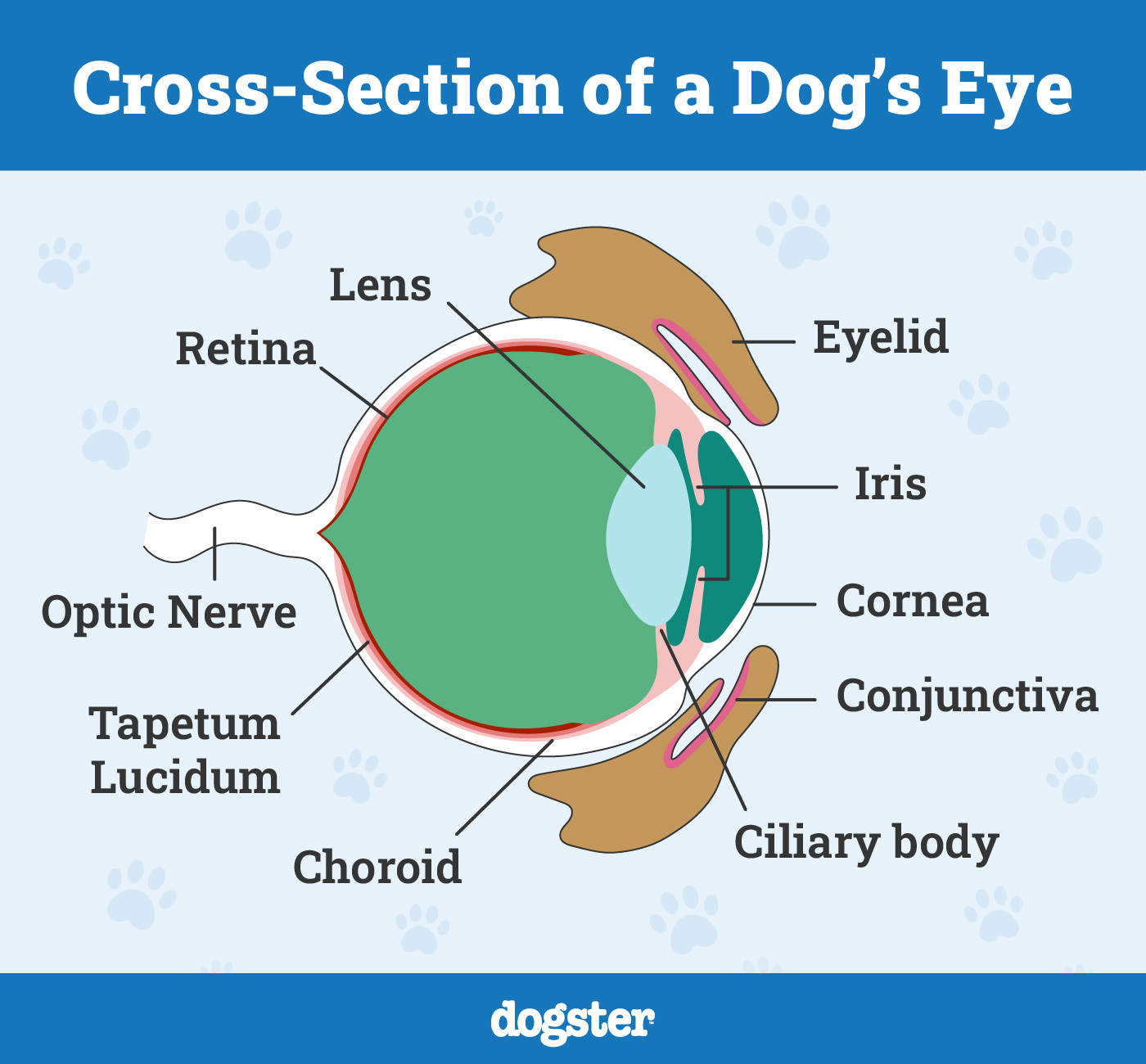
11. Glaucoma
Glaucoma is a very painful condition in which the internal pressure of the eyeball is increased due to fluid buildup. Glaucoma damages the optic nerve and can cause blindness. The vet uses a specialized medical tool called a tonometer to measure the pressure of the eye. Early detection makes treatment easier. Sometimes topical treatment with eye drops can be used, but other cases need laser surgery.

12. Hyphema
Hyphema is caused by bleeding in the anterior chamber of the eye, causing blood to be trapped between the cornea and the iris. It is usually caused by trauma, but uveitis, hypertension, infections, tumors, or coagulation disorders can also lead to this condition. Hyphema can cause glaucoma and is potentially blinding. If you notice blood inside your dog’s eyes, contact your vet immediately. Your vet will treat it depending on the causal factor.
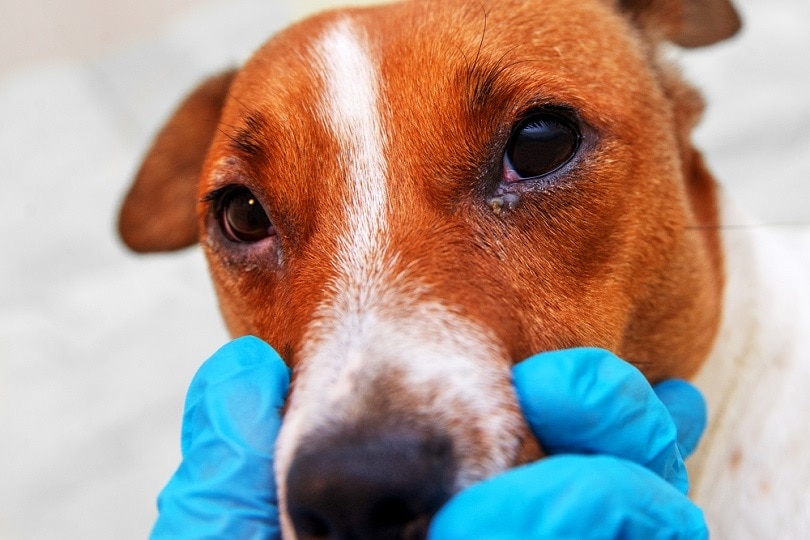
13. Tumor
Tumors in any part of your dog’s eyes can also cause redness in your dog’s eyes. A variety of benign and malignant tumors can affect the different structures of the eye. The treatment depends on the kind and placement of the growth and varies from surgical removal to radiation, completely removing the eye (enucleation) in the most severe cases.
If you want more information or are concerned about the health of your pet, you should contact your vet.
If you need to speak with a vet but can't get to one, head over to PangoVet. It's our online service where you can talk to a vet online and get the advice you need for your pet — all at an affordable price!
Related Reads:

Final Thoughts
Red eyes in a dog can be caused by something as simple as a dust particle. But it can also be as serious as a tumor that requires the eye to be removed. If this happens suddenly and you can see a particle on the eye, rinsing out the eye with a saline solution should do the trick.
However, if the eye remains red after a couple of minutes, it is necessary to visit the veterinarian to figure out what of the many possibilities is causing your dog’s eye to be red and find the appropriate treatment to resolve the issues before they complicate further.
See also:
- Cancer In Flat-Coated Retrievers: Is It Common?
- There’s a Bump on My Dog’s Eye: Should I Worry? (Vet Answer)
Featured Image Credit: Tatiane Silva, Shutterstock


